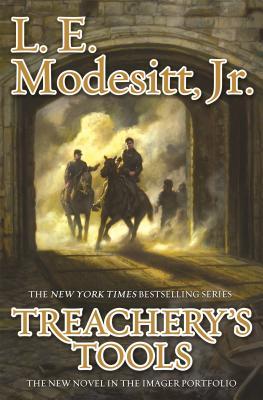 Treachery's Tools (Imager Portfolio, #10) by L.E. Modesitt Jr.
Treachery's Tools (Imager Portfolio, #10) by L.E. Modesitt Jr. Formats available: hardcover, ebook, audiobook
Series: Imager Portfolio #10
Pages: 512
Published by Tor Books on October 11th 2016
Purchasing Info: Author's Website, Publisher's Website, Amazon, Barnes & Noble, Kobo, Bookshop.org
Goodreads
Treachery's Tools is L. E. Modesitt's tenth novel in the New York Times bestselling Imager Portfolio fantasy series and begins thirteen years after the events of Madness in Solidar, Alastar has settled into his role as the Maitre of the Collegium. Now married with a daughter, he would like nothing better than to focus his efforts on improving Imager Isle and making it more self-sufficient.
However, the rise in fortune of the merchant classes in Solidar over the years does not sit well with the High Holders, who see the erosion of their long-enjoyed privileges. Bad harvests and worse weather spark acts of violence and murder. In the midst of the crisis, some High Holders call for repeals of the Codis Legis, taking authority away from the Rex.
Once again, Alastar must maintain a careful political balance, but he cannot avoid the involvement of the Collegium when someone begins killing students. Trying to protect his imagers and hold Solidar together for the good of all, Alastar stumbles on to a plot by the High Holders involving illegal weapons, insurrection, and conspiracy.
My Review:
They say that “age and treachery beat youth and skill”. In this book, the formula is more likely, “age and skill beat youth and treachery”. That’s not quite there either, but it’s a lot closer to the mark.
This is also a story about change, and the resistance to it. And because of that, Treachery’s Tools is primarily a political story. By that I mean politics as war conducted by other means, at least until war becomes necessary as a way of either cementing victory or preventing defeat.
Because the story is so steeped in politics, it is also a story about power corrupting. In this particular case, it is not much about absolute power corrupting absolutely, because no one in the story has that kind of power. They may want it, they may be fighting for it, but they don’t actually have it.
Instead, we have a story that has a lot of resonances with contemporary history. In the Solidar of Maitre Alastar’s time, the High Holders are slowly but surely losing their power. Not because they have done anything particularly wrong, although some individuals certainly have. But because they were on top in society as it was, and too many of them have hung on to their old ways as society has changed around them.
They liked the status quo, and don’t want to lose it. The problem is that the world is changing whether they like it or not, and more Factors (read businessmen), are amassing power and money even faster than the High Holders are losing it. Policy follows the money. The Factors have more money, and therefor more power. No one is doing anything evil per se, but time and tides are moving away from the large landholders and towards the manufacturers and businessmen.
Any parallels between the situation in the book and contemporary America, where the population is shifting to a majority minority population, and policies and attitudes are moving away from what the people who benefited from being in the old majority want to label as traditional, are in the eye of the beholder. But I think that they are there, right alongside a parallel to post-Industrial Revolution England.
In the story, the balance between all of the various factions is kept by the Imagers. Led by Alastar, they keep the balance because the strength of Solidar, and enforcement of its laws, keeps them safe. In turn, they try to keep the power balanced between the Rex, the High Holders, and the Factors because that provides the most stability for Solidar as a whole.
 Alastar was first introduced in Madness in Solidar, when he came from Westisle to the capital to deal with several crises, including a crazy Rex and a powerless Imager College. As much death and destruction as rained down on the capital in the process of setting things back on track, and as many deaths as could be laid directly at Alastar’s door, it’s been thirteen years since those events. People forget, especially when the events that they need to remember seem impossible.
Alastar was first introduced in Madness in Solidar, when he came from Westisle to the capital to deal with several crises, including a crazy Rex and a powerless Imager College. As much death and destruction as rained down on the capital in the process of setting things back on track, and as many deaths as could be laid directly at Alastar’s door, it’s been thirteen years since those events. People forget, especially when the events that they need to remember seem impossible.
So again, Alastar is forced to find a balance between an unworthy Rex, overreaching High Holders, recalcitrant Factors, traitorous colleagues and an Army that has divided upon itself. His only choice is to shore up as much as he can, because the alternatives all lead to darkness.
Escape Rating A: As I write this review, it is still May. I received the ARC two days ago, and I’ve already finished, knowing that I can’t post the review until October. And that I have a year to wait before the next book in the series, Assassin’s Price. It’s going to be a very long wait.
At the top, I used the saying about age and treachery beating youth and skill, because one of the underlying concepts that imbues this story is Alastar’s, and others’ perceptions of themselves, as getting older and not being as strong as they used to be. Alastar, now in his 50s, notices that he needs more time to recover from heavy imaging than he used to, and that he feels the aches of a day in the saddle or a serious beating on his shields a lot longer than he used to.
Alastar’s internal dilemma harkens back to the old Scandinavian saying, “We grow too soon old and too late smart.” He is so concerned that he is not the man he used to be, that he forgets that there is a value in the knowledge and wisdom he has accrued over the years, and that his worth to the Collegium is in that very wisdom. The Collegium and Solidar need him for his intellect, his wisdom, and sometimes his patience. (Not that he has much of the last, even now!) In some cases, they even give their lives to make sure that he is the one who will be leading, because they know that no one else is nearly as capable of keeping their country from going to hell in a handcart.
Alastar’s case contrasts sharply with that of the old general Wilkorn. Both men were a bit shortsighted, and that shortsightedness contributed to the civil war they face. But Wilkorn’s sin was in letting too many things slide, where Alastar’s was in not seeing all the dangers quickly enough and far enough in advance. There’s a big difference between sheer complacency and not being wise enough to see all ends, but still continuing to try.
Treachery’s Tools has a bit of a feeling of “middle book”. Not that the action all trends down into the dark, but in that the situation we face was set up in Madness in Solidar. And even though Alastar manages to resolve this crisis, it is all too obvious that his work is not done. He has bought a respite, but the forces that gathered are merely defeated and not destroyed. He will clearly face another crisis in the books yet to come, whether Assassin’s Price closes this chapter of Solidar history or whether it takes a bit longer.
 In other words, if the Imager Portfolio sounds like your cup of epic fantasy, Treachery’s Tools is not the place to start. Start with either Imager, the first book in the series as published, or Scholar, the first book in the Solidar chronological order. But if you enjoy epic fantasy with a political bent, the Imager Portfolio is utterly awesome.
In other words, if the Imager Portfolio sounds like your cup of epic fantasy, Treachery’s Tools is not the place to start. Start with either Imager, the first book in the series as published, or Scholar, the first book in the Solidar chronological order. But if you enjoy epic fantasy with a political bent, the Imager Portfolio is utterly awesome.























One thought on “Review: Treachery’s Tools by L.E. Modesitt Jr.”
Comments are closed.